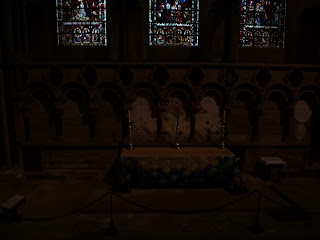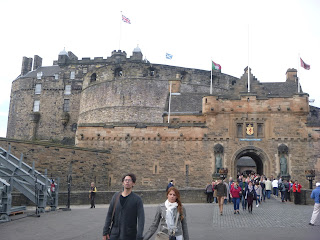The Pennine Way....
After visiting a local variety store in Settle, (where Iris bought some shoes), we wandered back to Ingleton for lunch and then, (sneakily), I decided to drive across the moors towards Hawes in upper Wensleydale. The route takes you between the Pennines on the eastern side and the lake district hills on the west and past some stunning countryside to boot.
Ingleborough from the north-west on a beautiful late September day. There is an iron-age fort on the top, if you can manage a two-hour, uphill stroll.
And looking in the other direction, across the upper-Ribble valley, towards the lakes. The moorland is probably the most sparsely populated part of England, (except for the lunatic drivers on the so-called main roads).
At the top of the valley there is one of the Victorian railway age's memorable constructions - the Ribblehead viaduct. Its 24 arches span the valley and the Carlisle-Settle railway still runs regular trains across it. It is now a listed historical monument.
The viaduct was built in the 1870s and over 100 men died during its construction. Something that thankfully, would not be countenanced nowadays. (Having said that, our current NZ government has just reneged on its promises to introduce better health and safety law, after our own Pike River mining disaster).
Continuing our drive, we passed many examples of previous generations' attempts to eke out a living on the moors. Derelict farm buildings and cottages such as the ones pictured below, were common.
A few miles before we got to Hawes, I spotted a signpost to Dent. I hadn't been there for many years so took the turn and headed down a steep road into Dentdale. We parked to check the view at the top of the valley, from our rental vehicle.
The campervan is in for repairs and we hired a "Ford Focus" but got upgraded to a Merc. I now not only look like Lewis Hamilton, but I drive a similar vehicle, (just as fast too).
Looking down into Dentdale over another of the many viaducts on the Carlisle to Settle railway.
When we reached the bottom of the hill, there was a small cottage nestled by the side of the road with a sign saying "Adam Sedgwick was born here in 1785". Well knock me down with a feather, who would have thought it!
We continued down Dentdale, along very narrow roads through the valley, to Dent itself, with fingers crossed that we wouldn't meet anything coming in the opposite direction. One of the bridges was so narrow that I wasn't too sure that the car would fit across it. It was a tight squeeze.
The bridge looks a lot better from this angle though.
We got to Dent without meeting any mega-vehicles and parked at the entry to the village. It is very unspoiled and has its original cobblestones right through the main streets. Immediately outside the church was a monument to the local mega-star, (yes, you've guessed it), Adam Sedgwick!
Here it is. A block of rock, with his name and dates. Despite the birthplace plaque and this monument, there was no other indication in the village or church of his claim to fame, so I had to google him. It turns out that he is considered to be one of the founders of modern geology. This despite the fact that he was a Church of England vicar and creationist and believed in Noah's flood and similar biblical events. It's always seemed very strange to me how some scientists, (who as a profession are usually amongst the more rational of thinkers), can believe in the irrational so readily.
We had a quick look around the village church which was a traditional church in many respects, including still having several yew trees in the grounds.
The nave and main window of the village church. There were also several notices about parish activities and a homespun tapestry at the rear of the church. One part of the tapestry in particular was of great interest to Iris, who has, you may remember, recently completed the "great scarf knitathon".
Not quite the Bayeux tapestry, but it was sufficient to get Iris looking for a membership form. She was very disappointed that there were none to be found, as she feels especially well qualified.
A view of the church with one of the yew trees in the foreground. These were not ancient yews, (as are to be found in some churchyards), but trees that have been planted in the last century. It's good to see the tradition being continued.
Dent churchyard with several Yews. (Don't get too excited you Kiwis, I'm talking about Yews not Ewes)!
A couple of views up and down the main street in Dent. We were lucky that it was an autumn weekday, as on a summer weekend, this would be Bedlam.
After our Dent-day afternoon we decided to head back to the M6, as Iris was not keen, (i.e. I was threatened with dismemberment), to continue all the way back to Carnforth on the country lanes. Unfortunately, there were about 15 miles of one-lane highway to negotiate, to get to the motorway. (When I say one-lane, I mean one lane coping with both directions of traffic).
During this interminable journey, we met other cars, trucks, vans and best of all a large agricultural behemoth, (towing at least 15 tonnes of cowshit), coming in the opposite direction. It's quite surprising how easy it is to continue driving straight through a hedge or a closed farm gate when you really need to, particularly when immersion in 15000 litres of manure is the alternative.
Eventually though, we reached the M6 and drove the 15 miles or so back home in about 11 minutes. Such are the joys of motorway driving.























































